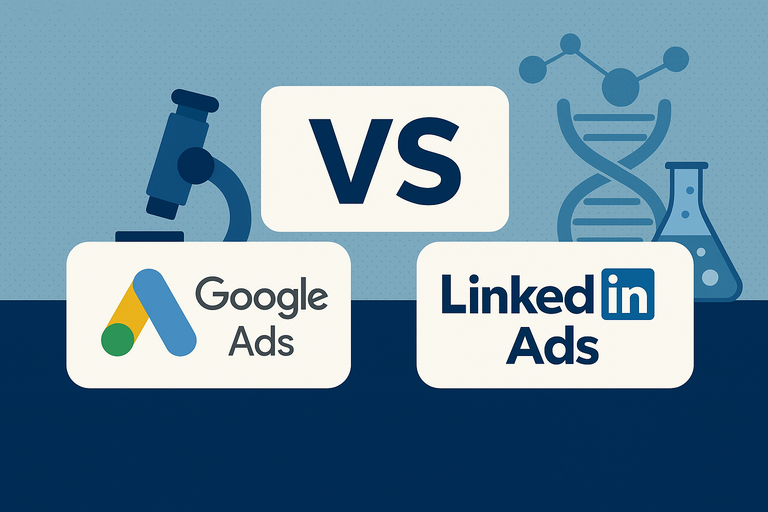Setting the right marketing budget for life science companies
Establishing a strategic marketing budget is not just about spending, it’s about investing wisely to drive growth and innovation. For life science companies, dedicating the right percentage of revenue towards marketing efforts is crucial. A well-crafted budget, created with a proven track record of strategy and execution, can significantly impact a company’s ability to compete, innovate, and scale effectively in this dynamic sector.
Table of contents
Why your marketing budget matters in the life sciences sector
For life science companies, the marketing budget is a powerful tool, not just for advertising, but for fueling growth, enhancing visibility, generating leads, and building credibility. A thoughtfully allocated percentage of revenue can unlock substantial ROI, considering the long sales cycles typical in this industry. Moreover, a strategic budgeting approach boosts investor confidence and strengthens market positioning, underpinning the critical role of marketing in achieving business success.
Factors that influence your life sciences marketing budget
Several key factors, including business goals, set a marketing foundation that dictates how funds are allocated across various marketing efforts. From engaging content marketing to targeted inbound marketing strategies, the allocation is influenced by the aim for revenue growth, the pursuit of potential customers, and the need to make a mark among B2B companies. The diversity of marketing activities, from content creation to leveraging digital transformation through healthcare marketing agencies, underscores the complexity of budgeting in this sector.
Company stage and business goals
In the life science sector, the company stage significantly impacts the marketing budget. Startups might drive rapid awareness through aggressive marketing, allocating a higher percentage of their revenue to life sciences marketing, potentially upwards of the average B2B marketing spend. This is because early stages often require substantial investment in brand visibility and market entry.
As a life science company matures, the focus may shift towards lead generation and product launches, necessitating a different allocation strategy. Here, the business model and marketing objectives evolve, possibly allocating 5% or more of revenue towards achieving these new goals, reflecting a shift in strategic priorities.
Ultimately, life sciences marketing must adapt as the company grows, balancing between sustaining growth and expanding market share. This dynamic approach allows for the refinement of marketing strategies in line with evolving business goals and market demands.
Industry benchmarks and budgeting models
Life science companies often look to industry benchmarks to guide their marketing spend, with many allocating between 5-10% of their revenue, though startups may invest more heavily. This investment in brand awareness and customer acquisition plays a critical role in a company’s ability to compete and grow.
Adopting budgeting models based on customer acquisition costs or marketing funnel goals allows companies to precisely allocate resources. For instance, SaaS companies within the life sciences may invest significantly in digital marketing to maximize conversion rates and customer lifetime value, setting goals that align with their unique business model.
This strategic approach enables life science companies to refine and optimize their marketing spend, ensuring each dollar contributes to brand visibility, customer engagement, and ultimately, business growth. By setting clear objectives and measuring against industry benchmarks, companies can navigate the complexities of the life sciences sector more effectively.
Target audience and channels
The life science sector’s audience type and the complexity of the offering significantly influence marketing budget allocation. A life science company offering platform technology may need a digital-heavy strategy to effectively communicate its value proposition, requiring a different budget allocation than a company focusing on a niche service.
Deciding between a conference-heavy or mixed marketing approach also impacts the budget. Companies must consider the competitive landscape, allocating funds to channels that will most effectively reach their target audience while also considering the average B2B marketing spend and the percentage of revenue dedicated to marketing efforts.
This tailored approach ensures that marketing dollars are spent wisely, maximizing the impact of each campaign and driving rapid engagement and conversion in the highly competitive life science sector.
Building a budget that aligns with the strategy
Aligning the marketing budget with a comprehensive strategy enables life science organizations to generate leads effectively while producing content that resonates with their audience. This strategic alignment ensures that every marketing dollar contributes to the overarching business objectives, maximizing the ROI from marketing investments.
Set clear objectives
For life science companies, setting clear objectives is foundational to effective budgeting. By defining what success looks like, whether it’s expanding market share, enhancing brand awareness, or driving specific product uptake, companies can allocate their marketing budget in a way that directly supports these goals. A percentage of revenue is then dedicated to achieving these objectives, reflecting the company’s strategic priorities within the life science sector.
This focused approach ensures that every aspect of the marketing plan, from digital campaigns to event sponsorships, is designed to move the company closer to its defined goals. It also allows for more accurate measurement of success and ROI, providing a clear framework for evaluating the effectiveness of marketing spend.
Prioritize channels with proven ROI
Life sciences companies must prioritize marketing channels with a proven track record of ROI. Channels like LinkedIn Ads, SEO, and webinars have shown consistent value in nurturing leads and building brand presence in the life sciences industry. By focusing on these digital channels, companies can more effectively reach their target audience and drive meaningful engagement.
Avoiding common pitfalls such as overinvestment in channels with high visibility but low conversion rates ensures that marketing budgets are spent efficiently, maximizing the impact of each dollar spent. This strategic allocation supports sustainable growth and enhances the company’s position in the highly competitive life sciences market.
Leave room for flexibility
While strategic planning is critical, life science companies must also leave room in their budgets for flexibility. This approach allows businesses to take advantage of unexpected opportunities or pivot their strategies in response to market changes. By reserving a portion of the budget for such contingencies, companies can adapt quickly, ensuring their marketing efforts remain effective and relevant.
This flexibility is particularly important in the fast-paced life sciences sector, where market dynamics and customer needs can evolve rapidly. Having the agility to adjust marketing strategies and spend ensures that companies can respond to these changes, maintaining their competitive edge and driving continuous growth.
Common pitfalls to avoid
One of the major pitfalls in life sciences marketing is undervaluing the importance of a strategic marketing approach. Marketing budgets that are not aligned with clear business objectives or that neglect performance tracking can lead to missed opportunities and inefficient use of resources. Additionally, life science companies must avoid the temptation to directly transplant B2C marketing models into their B2B strategies, as the audiences and decision-making processes differ significantly.
Another common mistake is failing to adapt marketing strategies and budgets in response to the dynamic nature of the life science industry. This sector requires a nuanced approach that considers the unique challenges and opportunities present. Companies that do not regularly review and adjust their marketing budgets risk falling behind more agile competitors.
Ensuring that every marketing dollar is spent with purpose is key to achieving long-term growth and success in the life sciences sector.
Tools for budget planning
Visualizing budgets on a monthly or quarterly basis, tied specifically to marketing campaigns, allows companies to more accurately forecast spend and measure effectiveness. This structured approach to budgeting not only enhances financial management but also aligns marketing efforts more closely with business objectives, ensuring that every dollar spent contributes to the company’s growth and success.
Conclusion
The importance of strategic, data-informed budgeting cannot be overstated in the competitive landscape of the life sciences sector. By carefully planning and regularly reviewing their marketing spend, companies can ensure that they are investing in the most effective channels and strategies to drive growth and innovation.
Life science companies are encouraged to continuously refine their marketing plans, leveraging market research and industry trends to stay ahead. This proactive approach is key to building customer loyalty, driving meaningful engagement, and vying for market share in the highly competitive and rapidly evolving life sciences industry.




